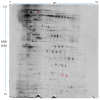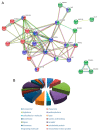Proteome Alterations in Equine Osteochondrotic Chondrocytes
- PMID: 31817880
- PMCID: PMC6940994
- DOI: 10.3390/ijms20246179
Proteome Alterations in Equine Osteochondrotic Chondrocytes
Abstract
Osteochondrosis is a failure of the endochondral ossification that affects developing joints in humans and several animal species. It is a localized idiopathic joint disorder characterized by focal chondronecrosis and growing cartilage retention, which can lead to the formation of fissures, subchondral bone cysts, or intra-articular fragments. Osteochondrosis is a complex multifactorial disease associated with extracellular matrix alterations and failure in chondrocyte differentiation, mainly due to genetic, biochemical, and nutritional factors, as well as traumas. This study describes the main proteomic alterations occurring in chondrocytes isolated from osteochondrotic cartilage fragments. A comparative analysis performed on equine osteochondrotic and healthy chondrocytes showed 26 protein species as differentially represented. In particular, quantitative changes in the extracellular matrix, cytoskeletal and chaperone proteins, and in cell adhesion and signaling molecules were observed in osteochondrotic cells, compared to healthy controls. Functional group analysis annotated most of these proteins in "growth plate and cartilage development", while others were included in "glycolysis and gluconeogenesis", "positive regulation of protein import", "cell-cell adhesion mediator activity", and "mitochondrion nucleoid". These results may help to clarify some chondrocyte functional alterations that may play a significant role in determining the onset and progression of equine osteochondrosis and, being related, of human juvenile osteochondrosis.
Keywords: chondrocytes; endochondral ossification; growth plate and cartilage development; horse; human juvenile osteochondrosis; joint diseases; osteochondrosis; proteomics.
Conflict of interest statement
The authors declare no conflict of interest.
Figures





References
MeSH terms
Substances
LinkOut - more resources
Full Text Sources

